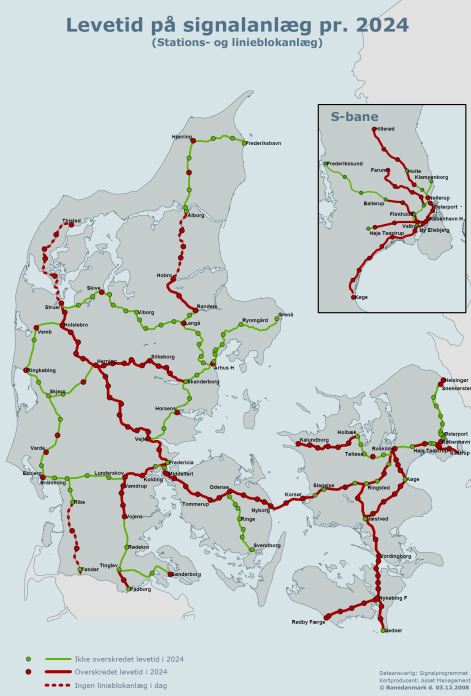Danish Signaling Program — Copenhagen, Denmark
Client

- Banedanmark (BDK)
Project Value 
€3.2 Billion
Market

Transportation
Services

Engineering, Program/Construction Management (PM/CM), Sustainability
The Danish signaling program is revolutionizing the rail network in Europe with It’s designed to enhance punctuality and reliability while reducing life-cycle costs through economies of scale, streamlined equipment, and centralized control systems. The project involves initial deployment on select lines for rigorous testing and approval, followed by a comprehensive rollout across main and regional routes.
Dramatic Improvements In System Performance and Reliability
The adoption of this new technology will reduce resource usage and signaling-related delays by 80% on the mainline system and 50% on the S-bane.
Passengers will benefit from improved train speeds, shorter travel times, and a consistent, high level of safety network wide. Moreover, the new system will deliver more accurate and timely traffic information, enhancing the overall passenger experience.
Transforming Denmark’s Rail Signaling Landscape
As part of our joint venture team with Systra and COWI, Parsons’ scope of work includes preparing tenders, negotiating contracts, overseeing suppliers, and implementing an early deployment scheme for the European Rail Traffic Management System (ERTMS) across Denmark’s mainline rail network. ERTMS, the continent’s standard for rail signal control systems, will be rolled out at Level 2, facilitating full interoperability and centralized traffic management. Additionally, we will integrate condition monitoring of components, align with passenger information systems, and elevate safety standards across the country. Upon completion, the program will have renewed the signaling systems of more than 3,200 kilometers of track and 560 train sets and locomotives from four major operators.

Parsons’ Sustainable Approach To Europe’s Largest Signaling Program
The Danish signaling program will be Europe’s largest, using the latest technology to make trains run on time more reliably. It will save money by using fewer resources and centralizing control. This initiative resonates with Parsons’ core principle of sustainability, as it emphasizes resource efficiency and reduced environmental impact, highlighting our dedication to responsible engineering practices and fostering a greener future for transportation.
The project will minimize environmental impact by using fewer natural resources and less cabling compared to traditional replacements.
S-Tog Automation Study
In 2010, Parsons conducted a study for the Danish Ministry of Transport to analyze the implementation of a driverless operation for the Copenhagen S-tog, a railway combining mainline and metro features. The Danish Ministry of Transport sought financially viable solutions for handling increasing passenger demand and were keen to explore driverless options. Parsons used its PRIME modeling tool to analyze various factors, revealing three strategic opportunities: transitioning to a driverless operation, adopting a metro-style service, and reorganizing service patterns. This underscores Parsons’ commitment to innovative transportation solutions and constantly working with our clients to imagine next.
Successful Migration To New GSM-R Network
In 2017, Banedanmark, in collaboration with Parsons, completed the migration of its voice and data radio network to a new nationwide GSM-R network covering 2,300 km of track in Denmark. This upgrade enables the handling of all train cab voice radio calls for approximately 800 rolling stock units operating within Denmark, as well as facilitating traffic communications with Germany and Sweden. During a planned 14 hour shutdown of the national network, all voice radio calls for dispatchers, train operators, and handheld terminals were disabled to facilitate the migration process. Following successful testing, the new GSM-R network was rolled out, supporting current operations and future integrations with Denmark’s new train control system (ERTMS).
Project Scope
- Engineering Management Office: development of engineering processes (security, interoperability, integration and testing, requirements management, configuration management, verification and validation management, commissioning).
- Conduct of the client part of the design, including the technical deliverables defined with the supplier,
- Assistance to the customer in the follow-up of the ERTMS subsystem supplier development activities (RBC, tags…), Interlocking and TMS.
- Participation in clarification meetings and technical arbitrations.
- Implementation of the Common Safety Methods (CSM) process for the entire project.
- Interfaces with independent safety assessment bodies.
- Conduct of supplier audits.
- Interface management.
- Analysis of human factors in the design,
- Monitoring of V & V activities and commissioning.
- Technical integration of the system (ERTMS Ground – Edge – GSMR integration) and operational integration of the system (integration of the technical system with the new operating rules).
Learn More
As global leaders take action against climate change, fully optimizing our rail and transit systems is more important than ever. The challenges we face require a visionary approach to modernize our transportation systems to decrease our dependence on personal vehicles and improve our ability to move within and between regions with greater efficiency. Learn more about our rail and transit expertise.

